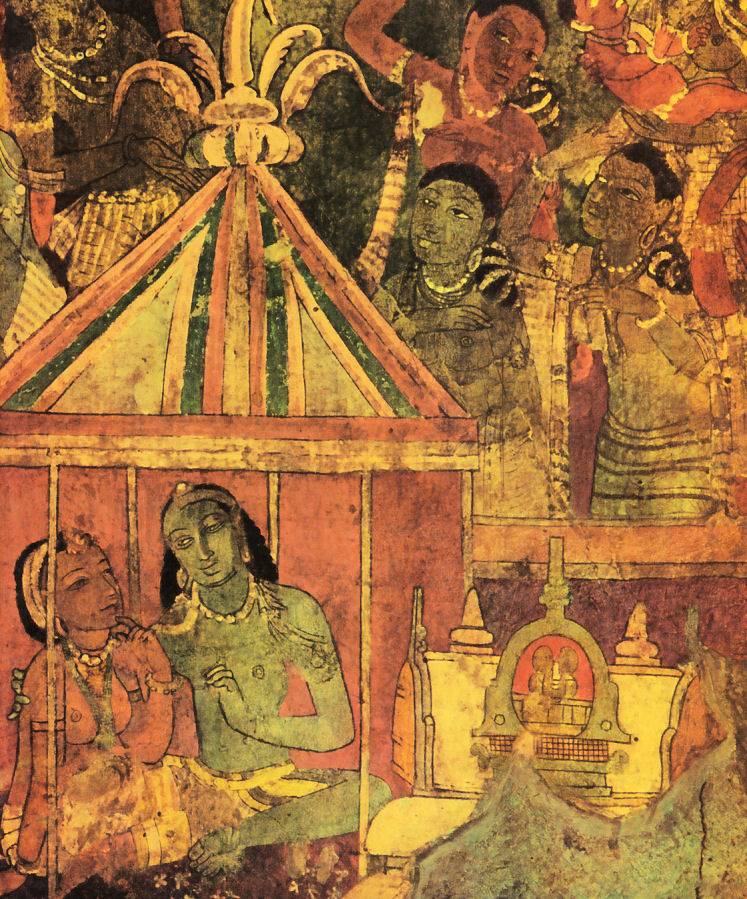
An ogress, transformed into a beautiful maiden (brown) seduces a gullible young prince (blue-green) shipwrecked on the dangerous island. More ogresses wait above the roof for the cannibal feast that he will become.
| Go to site main page. |
|

The courts of ancient India, like royal courts elsewhere, tended to siphon off economic resources into courtly luxury and extravagance, which often turned into a life of dissolution and sense of entitlement, especially (moralists argued) on the part of teenage royal princelings, who seemed to be at particular risk.
Thus in the courts of, say, the Mauryan empire (whose navy and foreign contacts exposed people to all sorts of unintended ideas), we see a growth of fanciful tales intended to show potentially wayward teenage royals the good effects of clean living and obedience to authority and the catastrophic results of giving in to temptation (especially sexual temptation) and/or of resisting authority.
(Non-royal teenagers were also considered to be at moral risk, but they generally lacked debilitating luxury and high position, so they had less potential to do serious damage to society than princelings did. As a result, they do not figure as characters in these stories very much. Presumably they were told plenty of moral tales anyway.)
Here is an example of such an account, illustrated by murals from the largely Buddhist mural paintings of the Ajanta Caves in the state of Maharashtra in western India. The cave decorations date from about 150 BC to about AD 500 or so.

An untransformed ogress (gray-green with yellow hair) sips blood from a transfixed sailor (brown) whose chest she has cut open
Once upon a time there was an island just off the Maharashtra coast. It was a terrible, rocky place, and many ships were sunk there or were beaten to pieces on its great, jagged rocks. Countless sailors and other travelers were lost to the sea in this dreaded place, and those few who made it to the shore rarely survived to tell of what they saw. Even today few dare even to speak of it, although all true sailors know that it exists, and that it poses a danger to ships that sail too close to it.
On this island there once dwelt (and perhaps still dwells) a population of ogresses, who had learned the art of transforming themselves temporarily into amazingly beautiful and voluptuous maidens, and who, giggling girlishly, would appear to shipwrecked men (especially young men) and promise them ample banquets and amorous entertainments.
The shipwrecked men, hungry and exhausted from being cast ashore without food, and filled with lust from their time at sea without female company, would nearly always agree, and would follow the ogresses to their lair, which appeared to the men to be pretty pavilions set up in a beautiful garden.

There the ogresses, still in the guise of beautiful maidens, would dally with the men, fill them with food and drink, excite their sexual desires, and addle their brains by magic. As each man reached the height of his satisfaction, an ogress would transfix him, slit his throat to drain out his blood, and open his chest and belly to remove his innards.
Then the ogresses, now back in their original, hideous forms, would make merry, happily drinking sailors’ blood and feasting on sailors’ flesh, as their giggling changed from girlish to fiendish.
Only the occasional very rare, very virtuous (and rarely very young) man, one able to resist the fatal seductions of the “maidens,” could escape such a fate if he landed on this island. Even then, he had to escape somehow, and it was rare to escape. It was even rarer still to remember clearly enough to warn others about the danger. That is the reason we know only a little about the island today.
(An odd, giggling noise can sometimes be heard along the Maharashtra shore today when the sea is about to claim more victims, which is why susceptible young men, especially when they are near the sea, should avoid pretty maidens who giggle.)
Retold from: